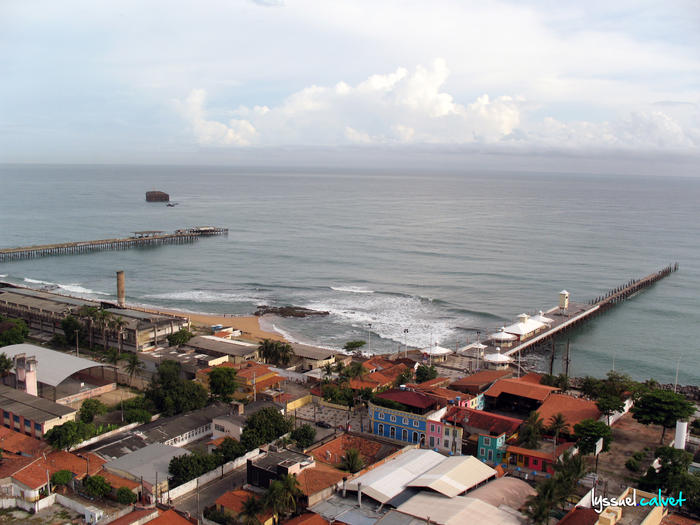| Academia Cearense de Letras - Palácio da Luz - MAP 3
Palace of Light
The former headquarters of the State Government - the Palace of Light was built at the end of the XIX century, with the help of indigenous labor, to serve as the residence of the master-mor Antônio de Castro Viana. Later owned by the City Council and a Royal Provision of 27 July 1814, was acquired by the Imperial Government. Even in the first half of the XIX century, the building went through a series of tra... |
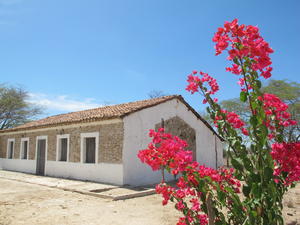 Casa José de Alencar - MAP 4
Passing through the bustling Washington Soares Avenue, there is a green space that breathes tranquility and culture: we are talking about the José de Alencar House.
The Casa José de Alencar is located in Sítio Novo Alagadiço, in the neighborhood of Messejana, in Fortaleza and was acquired in 1825 by José de Alencar Martiniano, father of writer José de Alencar, the main chara... Casa José de Alencar - MAP 4
Passing through the bustling Washington Soares Avenue, there is a green space that breathes tranquility and culture: we are talking about the José de Alencar House.
The Casa José de Alencar is located in Sítio Novo Alagadiço, in the neighborhood of Messejana, in Fortaleza and was acquired in 1825 by José de Alencar Martiniano, father of writer José de Alencar, the main chara... |
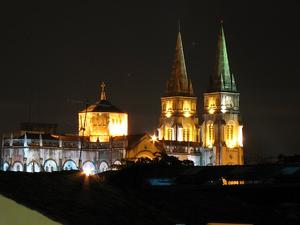 Cathedral by George Mounier - MAP 4
The Metropolitan Cathedral of Fortaleza one of the most significant religious buildings in the capital of Ceará is located a few meters from the Central Market of Fortaleza, a true temple of shopping.
Inspired by the French cathedral of Notre Dame, was designed by French engineer George Mounier and built on the site of the old church of the Cathedral. It was inaugurated on December 22th, 1978 and underwent a renovat... Cathedral by George Mounier - MAP 4
The Metropolitan Cathedral of Fortaleza one of the most significant religious buildings in the capital of Ceará is located a few meters from the Central Market of Fortaleza, a true temple of shopping.
Inspired by the French cathedral of Notre Dame, was designed by French engineer George Mounier and built on the site of the old church of the Cathedral. It was inaugurated on December 22th, 1978 and underwent a renovat... |
| Centro de Turismo - MAP 4
The former Public Jail, which houses the Tourist Center, was erected in 1850. Presently, in the places of the cells are stalls where you can find a variety of crafts from Ceará.
The upper floors of the building house the Museum of Popular Art, with religious and folk items, and the Museum of Mineralogy, with precious and semiprecious stones from Ceará and the Northeast.
Address: 350 Senador Pompeu Street -... |
| Estação Ferroviária Baturite - MAP 4 Baturité Railway Station.
The train "Smokey Mary" arrived and departed full of bags of coffee. Such was the routine railway station Baturité, strategic location for the distribution of coffee production from the interior to the capital of Ceara. The station was one of the first to be built in Ceará in 1870.
Today, the site preserves some of the equipment at that time, as the train "Smokey Mary", and save the architecture of the bu... |
| Estação João Felipe - MAP 4
Built in the Roman Doric style, by Austrian engineer Henrique Folgare, the Central Station Professor João Felipe which dominates the square Castro Carreira, is already 136 years. Its cornerstone was laid on November 30, 1873, but the works were only started in 1879, and thus inaugurated on June 9, 1880.
On its front there are four columns surmounted by a pediment, where there is a large clock.
The Central Station is th... |
| Estoril - MAP 4 The house with a foundation of class wood and covered with lime and clay, an architectural daring that time for a two-story building was erected in 1925 by businessman Jose de Magalhaes Ceara Porto.
It was the Vila Morena, located in the then Port of rafts, far away from the city center. The iron spiral staircase that leads to the upper floor of the house was brought from England. At the time of World War II, the family leased the p... |
| Fortaleza de Nossa Senhora da Assunção - MAP 4 The fort was built in 1649 by Dutchman Mathias Beck, who called Fort Shoonemborch. It was erected on the Marajaitiba hill near Pajeu creek.
In 1654, after the expulsion of the Dutch, the Portuguese occupied the fort, naming it the Fort of Our Lady of the Assumption.
It was around the fort that the village grew up until becoming a metropolis, a milestone which started up the city of Fortaleza.
The fortification is masonry (s... |
| Igreja do Senhor Bom Jesus dos Aflitos - MAP 4
The Bom Jesus dos Aflitos Church is located in the central square Parangaba, called the Caboclos da Parangaba square. Currently, the district that borders a lake of the same name, was formerly the Poranganba Indian village, founded by Jesuits in the XVI century. By the end of October, 1759, it was then named New Village of Arronches (Vila Nova do Arronches) a name of Portuguese origin.
The devotion of locals to the Good J... |
| Palacete Ceará - MAP 4
The palace is one of Ceará most representative works of the early decades of this century (1920), a period when major changes occurred in the architectural appearance of the city.
Projected by architect João Sabóia Barbosa, the building was owned by Mr.José Gentil Alves de Carvalho having been built by Rodolfo F. Silva e Filho.
Its lines reveal elements inherent in the architectural eclect... |
| Palácio do Bispo - MAP The palace was in the neighborhood Episcopal Outeiro, who is now the City Center. It was purchased in 1860 by the episcopate by deed before the Treasury of Finance on April 21, to Commander Joaquim Mendes Guimarães da Cruz and his wife Dona Joaquina and Colonel José Mendes Ribeiro Mendes da Cruz 60:000 Guimarães by the amount of $ 000, or So 60 contos, as authorized by the Ministry of Empire in Notice of March 12 this year cited.
... |
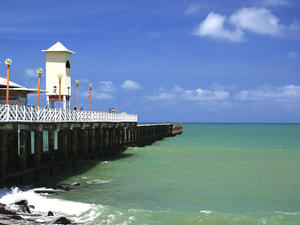 Ponte dos Ingleses - MAP 4 The English Bridge, popularly known as the Metal Bridge, has a long history of fascination on the population of Fortaleza and about their visitors.
Its construction began in December 1902 and lasted for four long years, rising to serve until 1940, the viaduct of embarkation and disembarkation of passengers and cargo in Fortaleza. This means that she played the important role of sea port to build the port Mucuripe in the early '40s.
... Ponte dos Ingleses - MAP 4 The English Bridge, popularly known as the Metal Bridge, has a long history of fascination on the population of Fortaleza and about their visitors.
Its construction began in December 1902 and lasted for four long years, rising to serve until 1940, the viaduct of embarkation and disembarkation of passengers and cargo in Fortaleza. This means that she played the important role of sea port to build the port Mucuripe in the early '40s.
... |
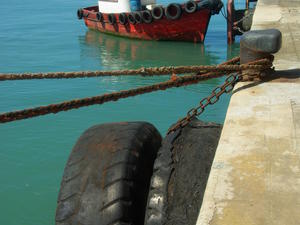 Porto do Mucuripe - MAP 4
Mucuripe, is one of the most traditional symbol of Fortaleza. Formerly, a bucolic fishing village, today blends rafts with modern skyscrapers and the omnipotent presence of the Port.
The charm of the place - where a projecting point of land advances the Atlantic and forms a beautiful cove - was and still is a source of inspiration for poets, singers and painters, among them the composers and Fagner, Belchior (the verses of th... Porto do Mucuripe - MAP 4
Mucuripe, is one of the most traditional symbol of Fortaleza. Formerly, a bucolic fishing village, today blends rafts with modern skyscrapers and the omnipotent presence of the Port.
The charm of the place - where a projecting point of land advances the Atlantic and forms a beautiful cove - was and still is a source of inspiration for poets, singers and painters, among them the composers and Fagner, Belchior (the verses of th... |
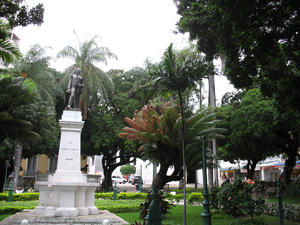 Praça dos Leões - MAP 4
In 1831 the "Palace Square" was planned and then the square begins to be urbanized being inaugurated in 1856. After the death of General Tiburcio Antonio Ferreira de Sousa, hero of the War of Paraguay in 1885, the first public statue of the city was erected in his honor on the square in 1888.
The General Tiburcio square or as it is popularly called the Lion Square is a square in the city of Fortaleza. The name is in ho... Praça dos Leões - MAP 4
In 1831 the "Palace Square" was planned and then the square begins to be urbanized being inaugurated in 1856. After the death of General Tiburcio Antonio Ferreira de Sousa, hero of the War of Paraguay in 1885, the first public statue of the city was erected in his honor on the square in 1888.
The General Tiburcio square or as it is popularly called the Lion Square is a square in the city of Fortaleza. The name is in ho... |
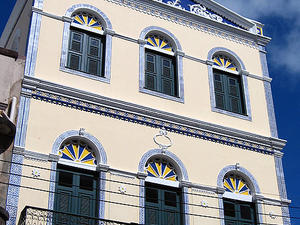 Sobrado do Doutor José Lourenço - MAP 4
The Dr. Jose Lourenço House, in the center of Fortaleza, presents an exhibition of legitimate pieces of Ceará craft. In addition to providing beauty products, you can also chat with the artisans and learn more about the techniques and history of art. The mansion serves as a unifying center of the visual arts of the state of Ceará, stimulating art and culture of Ceará, having as a star... Sobrado do Doutor José Lourenço - MAP 4
The Dr. Jose Lourenço House, in the center of Fortaleza, presents an exhibition of legitimate pieces of Ceará craft. In addition to providing beauty products, you can also chat with the artisans and learn more about the techniques and history of art. The mansion serves as a unifying center of the visual arts of the state of Ceará, stimulating art and culture of Ceará, having as a star... |
 Casa José de Alencar - MAP 4
Passing through the bustling Washington Soares Avenue, there is a green space that breathes tranquility and culture: we are talking about the José de Alencar House.
The Casa José de Alencar is located in Sítio Novo Alagadiço, in the neighborhood of Messejana, in Fortaleza and was acquired in 1825 by José de Alencar Martiniano, father of writer José de Alencar, the main chara...
Casa José de Alencar - MAP 4
Passing through the bustling Washington Soares Avenue, there is a green space that breathes tranquility and culture: we are talking about the José de Alencar House.
The Casa José de Alencar is located in Sítio Novo Alagadiço, in the neighborhood of Messejana, in Fortaleza and was acquired in 1825 by José de Alencar Martiniano, father of writer José de Alencar, the main chara... Cathedral by George Mounier - MAP 4
The Metropolitan Cathedral of Fortaleza one of the most significant religious buildings in the capital of Ceará is located a few meters from the Central Market of Fortaleza, a true temple of shopping.
Inspired by the French cathedral of Notre Dame, was designed by French engineer George Mounier and built on the site of the old church of the Cathedral. It was inaugurated on December 22th, 1978 and underwent a renovat...
Cathedral by George Mounier - MAP 4
The Metropolitan Cathedral of Fortaleza one of the most significant religious buildings in the capital of Ceará is located a few meters from the Central Market of Fortaleza, a true temple of shopping.
Inspired by the French cathedral of Notre Dame, was designed by French engineer George Mounier and built on the site of the old church of the Cathedral. It was inaugurated on December 22th, 1978 and underwent a renovat... Ponte dos Ingleses - MAP 4 The English Bridge, popularly known as the Metal Bridge, has a long history of fascination on the population of Fortaleza and about their visitors.
Its construction began in December 1902 and lasted for four long years, rising to serve until 1940, the viaduct of embarkation and disembarkation of passengers and cargo in Fortaleza. This means that she played the important role of sea port to build the port Mucuripe in the early '40s.
...
Ponte dos Ingleses - MAP 4 The English Bridge, popularly known as the Metal Bridge, has a long history of fascination on the population of Fortaleza and about their visitors.
Its construction began in December 1902 and lasted for four long years, rising to serve until 1940, the viaduct of embarkation and disembarkation of passengers and cargo in Fortaleza. This means that she played the important role of sea port to build the port Mucuripe in the early '40s.
... Porto do Mucuripe - MAP 4
Mucuripe, is one of the most traditional symbol of Fortaleza. Formerly, a bucolic fishing village, today blends rafts with modern skyscrapers and the omnipotent presence of the Port.
The charm of the place - where a projecting point of land advances the Atlantic and forms a beautiful cove - was and still is a source of inspiration for poets, singers and painters, among them the composers and Fagner, Belchior (the verses of th...
Porto do Mucuripe - MAP 4
Mucuripe, is one of the most traditional symbol of Fortaleza. Formerly, a bucolic fishing village, today blends rafts with modern skyscrapers and the omnipotent presence of the Port.
The charm of the place - where a projecting point of land advances the Atlantic and forms a beautiful cove - was and still is a source of inspiration for poets, singers and painters, among them the composers and Fagner, Belchior (the verses of th... Praça dos Leões - MAP 4
In 1831 the "Palace Square" was planned and then the square begins to be urbanized being inaugurated in 1856. After the death of General Tiburcio Antonio Ferreira de Sousa, hero of the War of Paraguay in 1885, the first public statue of the city was erected in his honor on the square in 1888.
The General Tiburcio square or as it is popularly called the Lion Square is a square in the city of Fortaleza. The name is in ho...
Praça dos Leões - MAP 4
In 1831 the "Palace Square" was planned and then the square begins to be urbanized being inaugurated in 1856. After the death of General Tiburcio Antonio Ferreira de Sousa, hero of the War of Paraguay in 1885, the first public statue of the city was erected in his honor on the square in 1888.
The General Tiburcio square or as it is popularly called the Lion Square is a square in the city of Fortaleza. The name is in ho... Sobrado do Doutor José Lourenço - MAP 4
The Dr. Jose Lourenço House, in the center of Fortaleza, presents an exhibition of legitimate pieces of Ceará craft. In addition to providing beauty products, you can also chat with the artisans and learn more about the techniques and history of art. The mansion serves as a unifying center of the visual arts of the state of Ceará, stimulating art and culture of Ceará, having as a star...
Sobrado do Doutor José Lourenço - MAP 4
The Dr. Jose Lourenço House, in the center of Fortaleza, presents an exhibition of legitimate pieces of Ceará craft. In addition to providing beauty products, you can also chat with the artisans and learn more about the techniques and history of art. The mansion serves as a unifying center of the visual arts of the state of Ceará, stimulating art and culture of Ceará, having as a star...
